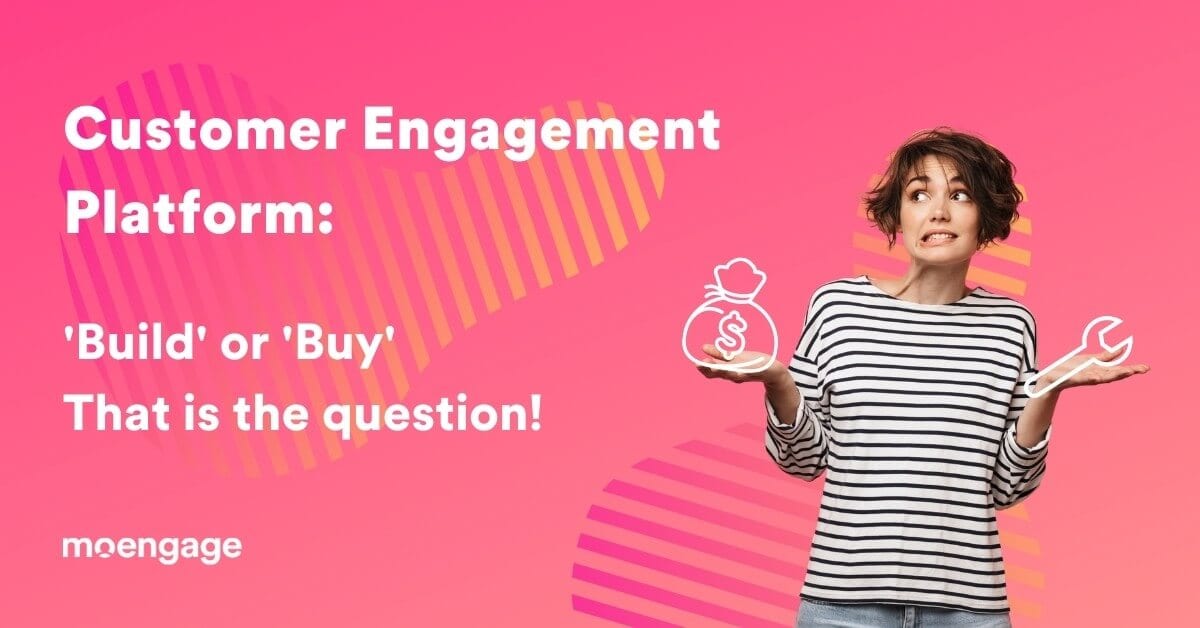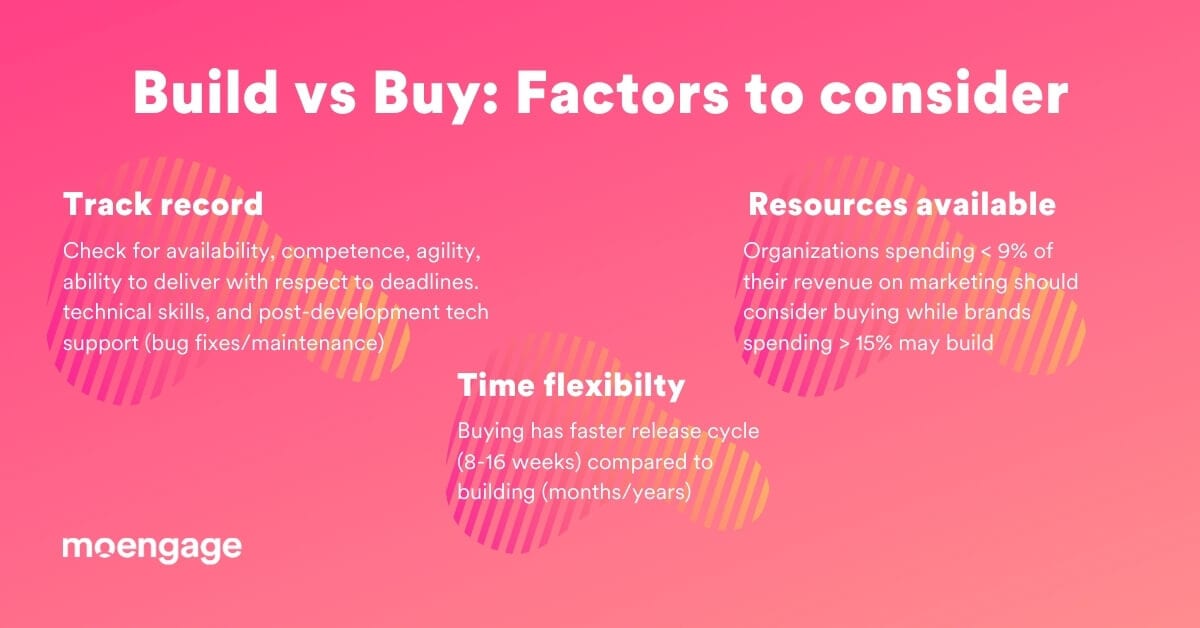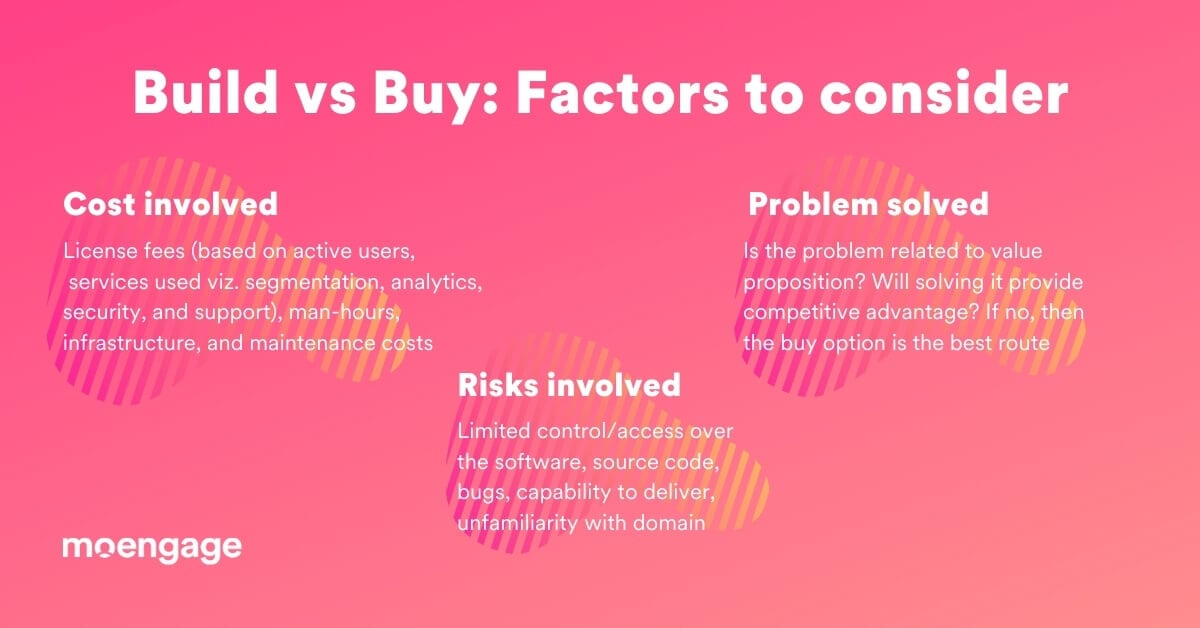Build vs Buy: Which is Better for a Customer Engagement Platform?

Reading Time: 7 minutes
Note: This article is a part of our special series focusing on the importance of an intelligent customer engagement platform and how you can choose one.
In today’s connected world where user experience is the topmost priority, a customer engagement platform is the need of the hour. In our earlier articles, we focussed on building a customer-centric culture and warning signs your brand needs an engagement platform. Through this article, we aim to settle the biggest debate when it comes to implementing a customer engagement platform: Build vs buy, which is better?
| Bonus Content
👉Definitive Buyer’s Guide To Customer Engagement Platform [Download Ebook] |
The build vs buy conundrum often pops up when you need to add some kind of technology to your stack, which in this case is an intelligent Customer Engagement Platform. At times, building something as intricate, detailed, and functional as a customer engagement platform requires a lot of time and resources that can be utilized elsewhere. But it isn’t that straightforward either. Before deciding if it is better to build a platform from scratch or acquire an existing technology, here are a couple of factors that you need to consider:
The cost involved: Build vs buy
The cost of building a large and complex engagement stack goes up with the size of the development team. While buying an existing solution, you need to consider license fees which vary based on active user count and services used viz. segmentation, automation, analytics, partner ecosystem, security, and support. Though there are no license fees involved in building, you will need to account for the man-hours, infrastructure, and maintenance costs, all of which are notoriously difficult to estimate accurately.
If you opt for building an in-house solution you need to be aware of the hidden costs. Here are a few of the most important ones, we have collated for you:
- Time to value: The waiting period between the start of development and final production has a cost attached to it. In-house development, in this case, is going to be a time-consuming matter. As a result, the cost of waiting till the platform is ready only grows with the complexity and functionality required.
- Technical debt: Also known as design or code debt, it is the implied cost that would go into additional development work to fix issues that can occur in the long run. While building an in-house solution, you will end up taking a significant amount of technical debt not only in terms of code changes but also overhead costs (i.e. storage and infrastructure)
- Maintenance cost: Prior to launching you can only do so much to ensure the product built in-house is operating seamlessly. However, even after finding and squashing bugs, with evolving technology, there might be new fixes in order. To prevent your solution from regressing, you need to invest in regular maintenance. According to estimates, companies on average end up spending anywhere between $10,0000-$25,000 per year on maintenance. With new compliance and legislation popping up amid growing privacy and security concerns, viz. GDPR (Europe), CCPA/ADA (US), PCI, HIPAA, etc. your technology needs to evolve to cater to these changes.
- Cost of training: One of the most important hidden costs of building in-house is one incurred in training post the development. The team/personnel currently maintaining the platform might disband sooner or later. In the case of employee turnover, you need to have a backup team ready to take charge of maintenance. The average recruitment and training cost for an employee can go upwards of $4000. But in order to function smoothly, you need to cross-train your team and ensure you avoid minimum capacity.
- Opportunity cost: Also known as alternative cost, simply put it is the benefit you could have enjoyed had you not chosen the option that you did. In the case of developing an engagement platform in-house, it is the work that your developers could have produced had they not been involved in building a solution using which you can provide a much more personalized experience to your end-user.
- Strategic costs: These are basically the costs incurred when your business wants to seize and address a new opportunity. The market needs being extremely time-sensitive need you to act urgently without any delay. A six-month wait might mean losing out to your competitors. The interesting fact is only 34% of the companies seek to get a first-mover advantage which essentially gives them a huge competitive edge. If you want this competitive advantage, you need to account for strategic costs on top of your existing maintenance and training costs.
Order our Buyer’s Guide to get a detailed resolution to build versus buy when it comes to an intelligent customer engagement platform
Accompanying risks to build vs buy
While building, the risk involved is mostly the capability to deliver. The development team’s unfamiliarity with the domain can often result in increased expense, among other troubles. The main risks involved with buying are limited control and access over the software, source code, and bugs. Make sure these issues are well communicated while buying the solution.
The problem being solved with build or buy
Is the specific problem you are trying to solve related in any way to your core customer value proposition? Will solving the problem yield any discernible competitive advantage? If the answer to the questions is no, then the buy option is the best route. Ask yourself if building a specialized solution from scratch adds directly to your bottom line. It is advised to buy stuff every company needs and build what actually differentiates you. For instance, consider an online food order and delivery service needs to resolve two problems. One being email functionality to communicate with users and the other building a seamless add-to-cart experience. While the latter directly contributes to providing a great user experience, the former isn’t tied to the core business objective. As such it is recommended the brand choose a proven email delivery partner and focus on improving the UX. The same reasoning goes for an intelligent customer engagement platform. The multi-device, hyper-connected world requires brands to engage users across channels. This is where a specialized platform with years of cutting edge technology built-in comes in handy.
Competitive advantage your brand seeks
It is very important to assess the competitive advantage your brand is seeking from a Customer Engagement Platform before deciding to buy or build. A few basic questions to get started are:
- What has been the brand’s historical preference for buying and building new technology?
- Determine if a third party platform can resolve more than 80% of your customer engagement needs.
- Identify if your brand operates in a mature industry and needs to prioritize differentiating experiences.
- Determine if a third party solution can keep up with your pace of innovation.
Track record of the development team
For the customer-focused brands of today, a customer engagement platform is the central point of your entire business growth. It is important to understand that everyone in your organization irrespective of tech-savvy will be utilizing this tool. As such it goes without saying that the platform not only needs to be functionally extensive but also incredibly user-friendly. Building such a platform would require a dedicated team of skilled developers and a significant amount of time. Before you choose between build vs buy, measure your development team’s skills and maturity. Check for availability, competence, agility, and the ability to deliver with respect to deadlines. To reiterate, you need to conduct a thorough check on bandwidth, technical skills, and post-development tech support (bug fixes/maintenance).
Resources available at your disposal for build vs buy
Budget is a big deciding factor when it comes to the build vs buy debate.
It is advised that organizations spending less than 9% of their revenue on marketing should consider buying while brands spending more than 15% of their revenue on marketing may decide to build a platform.
In the latter case, there is enough scope to realize the competitive advantage and it is likely that the development team has a proven track record of delivering user-friendly, custom solutions on time.
Time-to-market requirement for build vs buy
It is very important to be aware of the level of urgency to deploy the Customer Engagement Platform. You need to measure the gaps in marketing performance and analyze if your existing technology can act as a stop-gap while you build a platform over time. Buying a solution is a significantly faster go-to-market strategy as it can be delivered within eight to sixteen weeks (depending on the complexity of the use cases) compared to the months or years it can take to build a platform in-house.

To summarise we have broken down the pros and cons of build vs buy option, in this table below:
| Build | Buy |
| Lower upfront costs since there is no subscription fee and the infrastructure is already in place | You’ll be investing in subscription fees upfront but often there’s a free trial period |
| Slow-release cycles with dependence on in-house teams to execute new features | Accelerated time to the market owing to a ready-to-deploy platform |
| The inability of in-house resources to keep up with complicated and emerging needs. | Third-party solutions come with expert IT and marketing support along with service parameters defined within SLAs. |
| The high total cost of ownership in the long run with developer costs, integration, and infrastructure overheads | The significantly lower total cost of ownership owing to the fixed monthly or yearly licensing structure. |
Now, that you have gone through the pros and cons of build vs buy, we hope it will make the decision easier. Our advice is before choosing either solution, sit with your team, and go through the above-mentioned checkpoints carefully. While sometimes it makes sense to go with a solution that has been built over decades versus starting from scratch, the choice isn’t so easy always. Some brands pick and choose from both build and buy options, to create their winning combo. Most importantly, it doesn’t matter whether you choose to buy a third-party solution or build a platform from scratch; how successful your customer engagement effort really depends on how you implement it.
We at MoEngage are dedicated to helping you provide the best possible experience to your end-user. If you’re struggling to choose between build vs buy, get in touch with us today! Feel the difference with the platform that has helped Nestle, Samsung, McAfee, Deutsche Telekom, Landmark Group, Airtel, OYO, and other global brands.
Here’s What You Can Read Next
|














